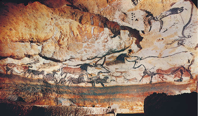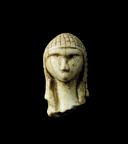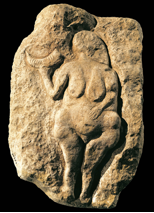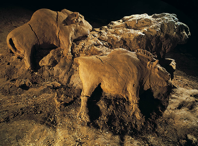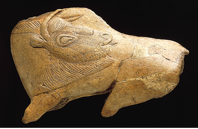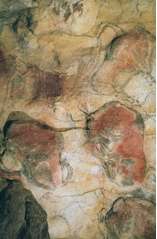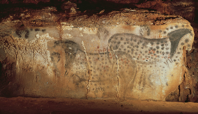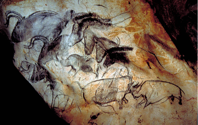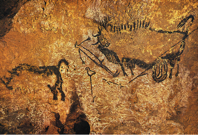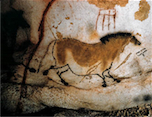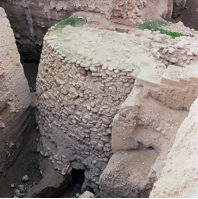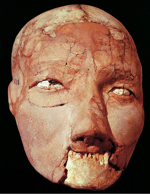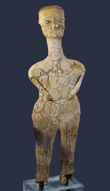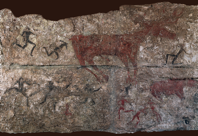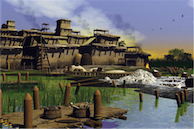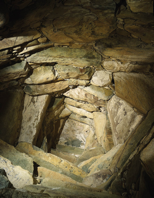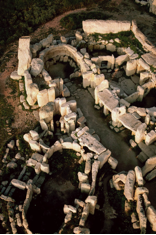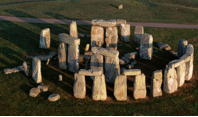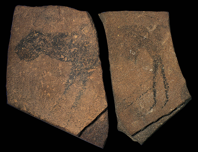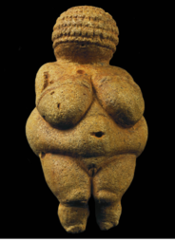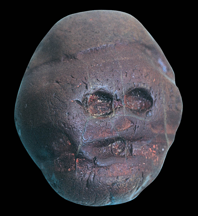Left wall of the Hall of the bulls in the cave at Lascaux, France
15,000-13,000 BCE
Largest bull 11'6" long
Human with feline head, from Hohlenstein-Stadel, Germany
30,000-28,000 BCE
Mammoth Ivory
11 5/8" tall
one of the oldest know ivory sculptures. composite creature or human wearing an animal mask?
Head of a woman, Brassempouy
1 1/2" high
made of ivory
25,000-20,000 BCE
Woman holding a bison horn, from Laussel, France
25,000-20,000 BCE
Painted limestone
1'6" high
One of the oldest known relief sculptures depicts a woman who holds a bison horn and left arm draws attention to her belly.
Two bison, reliefs in the cave at Le Tuc d'Audoubert, France
15,000-10,000 BCE
Clay
right bison 2' 7/8" long
Built using a stone spatula-like smoothing tool and fingers to shape the details.
Bison licking it's flank, fragmentary spear-thrower, from La Madeleine, France
12,000 BCE
Reindeer horn
4 1/8" long
Sculptor turned the bison's head a full 180 degrees to maintain the profile view and incised the details with a stone burin.
Bison, detail of a painted ceiling in the cave of Altamira, Spain
13,000-11,000 BCE
Standing bison 5' 2.5" long
no ground line or indication of setting.
sole concern was to represent the animals not to locate them in a specific place.
Spotted horses and negative hand imprints, wall painting in the cave at Pech-Merle, France
23,000-22,000 BCE
11' 2" long
Purpose and Meaning unknown. think the painted hands near the Pech-Merle horses are "signatures" of community members or of individual painters.
Aurochs, horses, and rhinoceroses, wall painting in the Chauvet Cave, Vallon-Pont-d' Arc, France
30,000-28,000 BCE or 15,000-13,000 BCE
Right rhinoceros 3' 4"long
They exhibit surprisingly advanced features, such as overlapping animal horns.
Rhinoceros, wounded man, and disemboweled bison, painting in the well of the cave at Lascaux
16,000-14,000 BCE
Bison 3' 4 1/2" long
Constitute the earliest example of narrative art ever discovered.
"Chinese horse" Lascaux
16,000-14,000 BCE
4' 11" long
Stone tower built into the settlement wall, Jericho
8,000-7,000 BCE
Protecting Neolithic Jericho were 5' thick walls and at least one tower 30' high and 33' in diameter contructed of stone laid without mortar
Human skull with restored features, from Jericho
7200-6700BCE
Modeled in plaster, painted, and inlaid with seashells.
Life-size.
Farmers removed the skulls of their dead before burial, modeled them in plaster, and inlaid the eyes to create lifelike "portraits" of their ancestors.
Human figure, from Ain Ghazal, Jordan
6750-6250 BCE.
Plaster, painted and inlaid with bitumen
3' 5 3/8" high
the dozens found are earliest large-scale sculptures known.
Deer hunt, detail of a wall painting from level III
5750 BCE
Painter depicted human figures as a composite of frontal and profile views, the most descriptive picture of the shape of the human body. became the rule for millennia.
restored view of Catal Hoyuk
6000-5900 BCE
Houses in the early city adjoined with one another and had no doors. Openings in the roof provided access to the interiors.
Landscape with volcanic eruption, Catal Hoyuk, Turkey
6150 BCE
detail of a watercolor copy of a wall painting from level VII.
First known landscape painting in which neither humans nor animals appear.
Corbeled vault of the main chamber in the passage grave, Newgrange, Ireland
3200-2500 BCE
Early example of corbeled vaulting.
Aerial view of the ruins of Hagaar Qim, Malta
3200-2500 BCE
Neolithic builders incorporated both rectilinear and curved forms.
Aerial of stonehenge, Salisbury Plain, Whiltshire, England
2550-1600 BCE
Circle 97' in diameter
trilithons 24' high
trilithons probably functioned as an astronomical observatory and solar calendar.
Some of the megaliths weigh 50 tons.
Animal facing left, from the Apollo 11 Cave, Namibia
23,000 BCE
charcoal on stone
4 1/4" X 5"
Nude Woman (Venus of Willendorf), from Willendorf, Austria
28,000-25,000 BCE
Limestone
4 1/4" high
typical of Paleolithic representations of women, whose child-bearing capabilities ensured the survival of the species.
Waterworn pebble resembling a human face, from Makapansgat, South Africa
3,000,000 BCE
reddish-brown jasperite
2 3/8" wide
Stone is not an artwork because it was neither manufactured nor modified.
